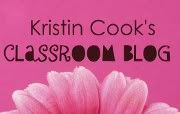So I'm jumping on The Daily Five book study band wagon that is being linked through Mel D's blog . . .
You can pick up freebies, a book study schedule, and more there! If you have a blog, be sure to join the linky party! OK . . . now back to the book.
Here are the questions posed by Mel D. and answered by yours truly. If you'd like to comment or post your own responses, feel free!
Here's my overall reaction to Chapter 1: This is a true example of authentic action research!
1. On pages 4-6, the authors present two different pictures of their classrooms. In thinking about and reflecting on your own practice, how would you characterize your literacy block? Does it look more like the first or second scenario, or is it somewhere in between? How will you change it?
As I was reading these pages, I was literally laughing out loud! I even called my mom (a teacher) and a teaching friend and read it out loud to them! They were LOL-ing too! All I could think is, "This is so true of my classroom." Scenario One fits my classroom to a T! Over my 8-year teaching career, I have spent countless hours creating, prepping, managing, and reviewing student work at my centers and, more recently, my stations. It is exhausting! To read Gail and Joan's reflection and testimonial about how well their plan works gives me hope that it is possible to feel relaxed in knowing that the time, for both myself and the students, spent doing The Daily Five will be quality learning at its best. I look forward to enjoying the sunny weather outside! I believe that the key is changing the management system. We as teachers know that if you are lacking in classroom and behavior management, then teaching and, more importantly, learning cannot and will not take place. Therefore, The Daily Five management system holds the key to student independence without sacrificing learning and achievement.
On a side note, my "Ah-Ha" moment was when I read Figure 1-1. Normally, I'm so focused on the writing that I barely notice figures, images, photos, etc. but since this figure took up almost 3 pages of chapter 1, "I figured" (hahahaha) that I should check it out. There were actually two "Ah-Ha's". . . the first being the "Whose classroom is it?" where after Gail and Joan implemented The Daily Five the teachers' desks took up the same amount of space as a student's desk, 1/20th. This will certainly take some changing for me! I definitely like my executive office that has many "satellites" throughout the classroom. Post-it notes here, tape dispensers there, pens near the window, etc. Starting The Daily Five will require me to go "HOME" as E.T . would say. The second "Ah-Ha" moment was with the "Locus of Control", wherein it is a complete shift from external to internal motivation for students. At my school, we are a PBS school which is 100% rewards motivated. Therefore, to implement The Daily Five, the locus of control during The Daily Five will need to be strictly internal.
Hmmm. . . I will need to focus more on these figures. . .
2. The typical teacher is very busy having students do lots of different activities. How is what you are having students do now in your classroom creating quality readers and writers?
This is a tough one. . . I want to say that all of my activities are creating quality readers and writers, however, I believe that this is more of "what I should say" rather than what is true.
Before I put myself under scrutiny, I will say this. . .I believe that the true determiner of whether or not the activities/centers/stations during my literacy block are quality is the fact that several of my students have asked at random parts of the day (pack-up time, during bathroom/drink time, or during odd moments throughout the year) if they can go to a particular center/station. I then ask them which one they were thinking about . . . expecting that they will say "Computers" or one of the other "fun" ones . . . and to my relief . . . almost all of the students have asked to go to one of the following:
- Read the Room Station/Center
- Reading Station/Center
- Writing Station/Center
Now onto answering the question . . .
Upon further examination/reflection. some of the tasks I have students complete do seem like busy-work because they are sometimes the things that keep the students "out of my hair" so that I can work with my reading groups. Recently, I often spend hours scouring Pinterest to see what "easy to make" printables/games are available for me to use as a station/center without giving more thought as to creating quality readers/writers and more-so thinking to myself, "This is something that the students need to practice anyway soooo why not!" I know this needs to change and hope remains for The Daily Five.
A Daily Five question that I still have is. . . how do I know whether or not this particular Daily Five activity is truly creating quality readers/writers?
3. What sets the Daily 5 structure apart from what you are doing in your classroom?
Honestly it is a total paradigm shift in thinking and managing the classroom. I really liked how the class chooses what jobs need to happen in the classroom instead of the teacher using a "Job Chart" which is what I use. I'm anxious to read the next chapter in hopes that these questions/thoughts will be addressed.
STAY TUNED!
Educationally yours,









































1 comments:
I also had a few of those out of the hair pages but I tried to make it meaningful, I also want to be more thoughtful in this regard! Good luck!
Post a Comment